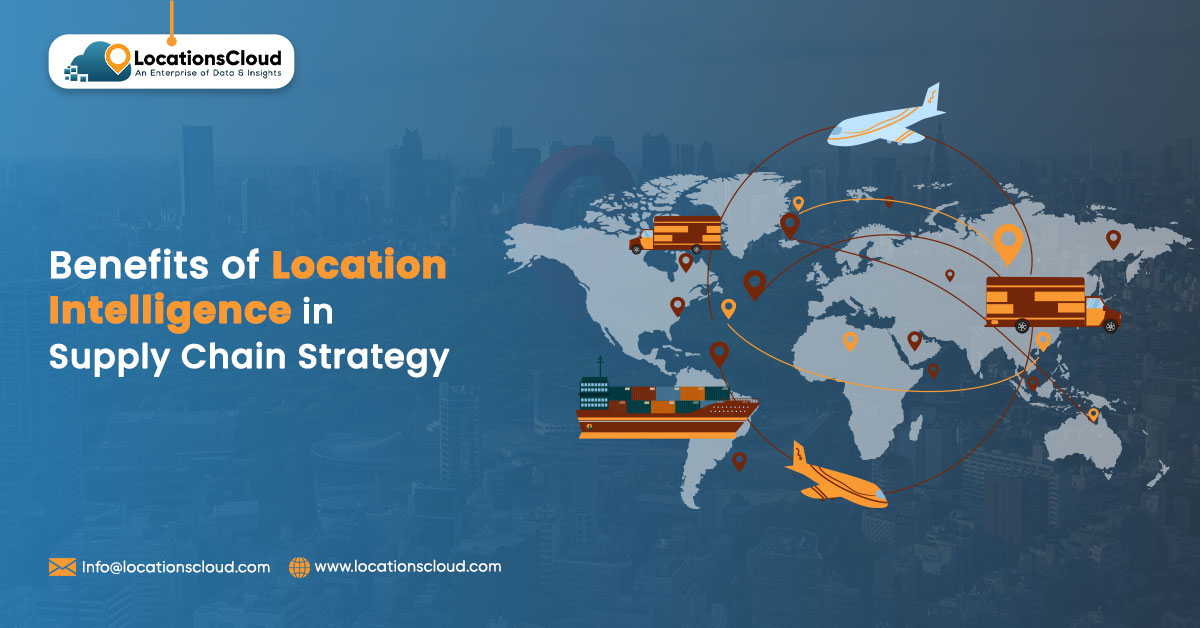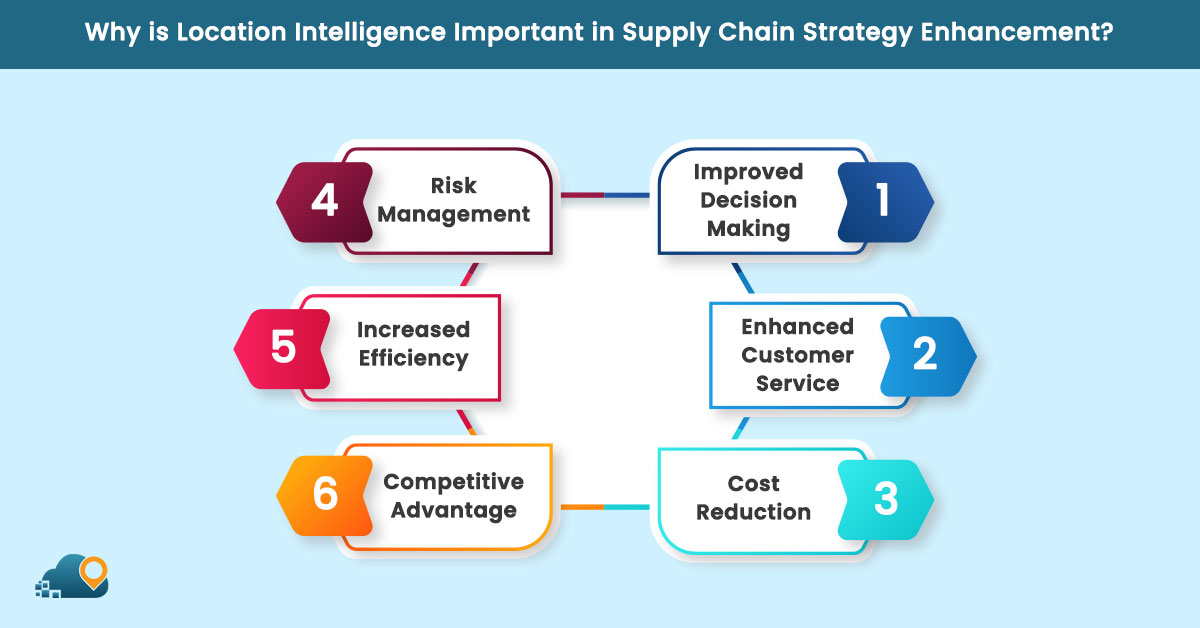
Location intelligence is a powerful tool businesses can use to gain an advantage in their supply chain operations. It involves using location data to make smarter decisions. This data can include customer information, suppliers, transportation routes, and weather patterns. Knowing where things are is helpful for businesses. They can use this information to make their operations work better. This information includes where customers are, suppliers are, the best transport methods, and the weather. When businesses use this information smartly, it can help improve their operations, cost less, and be more robust. This blog will explore how location intelligence can give businesses a competitive edge in their supply chain strategy.
What is Location Intelligence?
Location intelligence means gathering, analyzing, and visualizing data about geographic locations. They collect and look at information about places using GPS, phones, social media, and satellite pictures. It helps them learn valuable things about how people move and how it affects their business. By studying this data, companies can gain valuable insights into patterns and trends that affect their operations.
Why is Location Intelligence Important in Supply Chain Strategy Enhancement?

The efficient movement of products from suppliers to customers is crucial for businesses. It involves the entire process, from sourcing raw materials to delivering the final products. Companies must have an efficient system to meet customer demands, reduce costs, and stay competitive.
Using location intelligence to optimize supply chain operations is important because it provides accurate and timely information about various factors influencing the supply chain. Location intelligence is when we use real-time information and ideas to help businesses make better decisions. Here are some of the key benefits:
Improved Decision Making
Businesses use location intelligence to make better decisions using accurate and current geographical data. This information can be helpful in various ways, such as:
- Finding the best locations for warehouses, distribution centers, and retail stores.
- Planning delivery routes to save on fuel costs and delivery times.
- Finding new opportunities for growth and expansion.
Enhanced Customer Service
Businesses can better understand their customers’ needs and preferences using location intelligence. It can improve customer service in several ways:
- Get products to customers faster by finding the best delivery routes and warehouse locations.
- Attract more customers by offering promotions and deals based on their location.
- Keep popular products in stock by knowing where they are in the highest demand.
Cost Reduction
Location intelligence can be instrumental in helping any business lower costs.
- Remember that using location information can help businesses save money. You can spend less on transportation by finding the best routes and using efficient delivery methods.
- Also, you can reduce costs by storing products in the right places to meet demand without having too much inventory.
- Lastly, you can save money by finding and fixing problems in getting supplies.
Risk Management
Supply chains can face many dangers, like earthquakes, protests, and market changes. Location intelligence can help companies deal with these dangers in these ways:
- Finding possible dangers: Companies can use location intelligence to understand and prepare for what might go wrong.
- Making alternative plans: Companies can ensure that it only affects them slightly when something goes wrong by creating different plans for what might happen.
- Improving communication: Getting real-time information can help companies quickly handle problems.
Increased Efficiency
Efficient supply chains are crucial for success. Using location intelligence can help make operations more efficient in several ways:
- Using data to find the best routes and delivery methods can help logistics.
- Knowing where products are needed most can reduce waste and ensure timely deliveries, improving inventory management.
- Providing real-time data to all involved parties can improve communication and coordination, enhancing collaboration.
Competitive Advantage
In today’s challenging business world, companies need to be innovative. Being aware of the location of items can be helpful. Here’s how:
- Companies can grow by finding new opportunities through understanding what customers prefer.
- Companies should provide faster and better service to keep customers happy.
- Additionally, companies can gain an edge over their competitors by using information to make informed decisions.
Types of Location Data in Supply Chain Management
Location Data is critical in modern supply chain management. It gives us important insights into where goods are and how they move through the logistics network.
- Geospatial Data: This data helps us visualize the layout of the supply chain network and find the best locations for warehouses, distribution centers, and stores.
- Real-time Tracking: GPS and RFID help you see where your goods move. This information makes it easier to manage your things, know what you have in stock, and respond better to your needs.
- Historical Data: To make good decisions, looking at past information about where things happened is essential. Knowing what happened before can help us figure out what people want, find the best way to go somewhere, and understand the possible problems that might come up again.
How to Implement Location Intelligence in Your Supply Chain Strategy?
Using information about geographical data, companies can learn important things that help them work better, spend less money, and make better decisions. Integrating location information into your supply chain plan might seem complicated, but it can be divided into smaller steps.
Practical Steps for Integration
Using location data in your supply chain means making good decisions from maps and location intelligence. This helps improve everything, like moving things around and managing how things get where they need to be.
- Identify Objectives: Identify the problems you have with getting and delivering products that location intelligence can help with. It’s essential to have specific goals, like making your delivery routes the best they can be, handling your inventory better, or reducing risks.
- Data Collection: Gather important location data from various sources, such as GPS devices, IoT sensors, and other data sources. Ensure that the data is correct and accurate to make good decisions.
- GIS Software Selection: Choose a good Geographic Information System (GIS) software that fits your business needs. Consider how easy it is to use, whether it can grow with your needs, and whether it can work well with other software.
- Integration with Existing Systems: APIs and data connectors make it easy to add location intelligence to your supply chain planning software and systems.
- Data Analysis: Utilize powerful GIS tools to examine the gathered location data thoroughly. Create compelling visual representations of trends, patterns, and connections, providing invaluable insights to facilitate informed decision-making.
What are the Challenges to Overcome the Implementation ?
Carrying out a plan can be challenging. Overcoming these challenges is crucial for success in business, technology, or different projects.
- Data Quality: Out-of-date location data can lead to wrong decisions. Check and correct any errors to ensure the information is accurate.
- Change Management: Ensure employees receive training and support to help them adjust to new tools and methods. This will ensure a smooth transition and encourage widespread adoption.
- Integration Complexity: Combining location intelligence with current systems can be difficult. Work with IT professionals or advisors to handle integration challenges successfully.
- Privacy and Security: Protect important location information from people who shouldn’t see it. Use robust security methods and follow the rules for keeping data secure.
- Resource Allocation: To use location intelligence, you must plan carefully and budget your time and money. Make a detailed plan with transparent costs and timing.
Real-World Examples of Location Intelligence in Supply Chain Strategy
Let’s see how businesses use location data in the real world to improve their movement from one place to another.
Example 1: Amazon
Amazon is an excellent example of a company that uses location information to improve its delivery system. By looking at data about different places, Amazon can do three main things:
- Find the best places for its warehouses so it can deliver things to customers quickly and without spending too much money on transportation.
- Figure out the best ways to deliver things to people so they can save money on gas and get things to customers more quickly.
- Keep track of what is most prevalent in different places so they always have enough of those things in stock to sell.
Example 2: Walmart
Walmart is a company that has used innovative information about places in its plan to get products from one place to another. By using data about where things are, Walmart can:
- Please find the best places to put stores. Walmart studies data to find the best spots for new stores, ensuring they are easy for customers to access.
- Make deliveries better: By using updated information, Walmart can find the fastest ways to bring things to stores and spend less money on delivery.
- Make sure there’s a manageable amount of something: Walmart uses innovative information about places to ensure they have the right amount of things in the right places, so they have enough for customers but not too much.
What are the Challenges and Solutions in Implementing Location Intelligence?
Using location intelligence in your supply chain strategy has advantages but can also be challenging. Here are some problems and solutions you might face.
● Data Collection: It can be challenging for big companies with many moving parts to get the right location data. To fix this, trustworthy sources and tools can be used to gather data and ensure its accuracy.
● Data Analysis: Dealing with much information can be difficult and take a long time. Use special tools and software to help sort and understand the information quickly and effectively.
● Integration: Adding location intelligence to managing your supply chain can be challenging, especially if you have many different systems. What to do: Get help from people who know how to make everything work together and can support you as you go.
What are The Future of Location Intelligence in Supply Chain Strategy?
As technology improves, location intelligence in supply chain plans will become more popular. Here are some things to look out for in the future:
- Increased Use of AI and Machine Learning
Artificial intelligence (AI) and machine learning will become more critical in location intelligence. These technologies can help analyze data faster and more accurately, providing more helpful information.
- Greater Integration with IoT
The Internet of Things (IoT) involves connecting everyday objects to the Internet so they can send and receive data. This is expected to work closely with location intelligence. Devices connected to the IoT can give us information right away, which we can use to improve supply chain operations.
- Enhanced Data Visualization
Data visualization tools will improve their ability to show information on maps, which will help businesses understand and use location-based data more easily.
Conclusion
In today’s world of managing how things are moved from one place to another, where things are very complicated and lots of companies are competing, using location intelligence is becoming very important. Location intelligence is a vital tool that can help businesses in many ways, like making better decisions, giving better service to customers, spending less money, and working better. When enterprises use location information, they can be better than their competitors and be successful for a long time.
LocationsCloud can help businesses gain a significant advantage using geospatial data, real-time tracking, and historical information. It can help them see things better, plan the best routes, predict demand, and lower risks. Companies that use this location information in their supply chain plans are set up to do well in the changing market.


